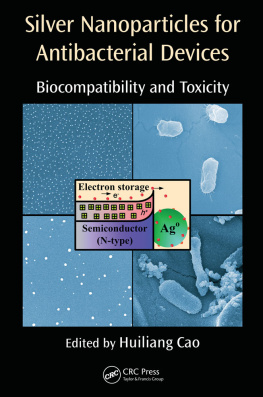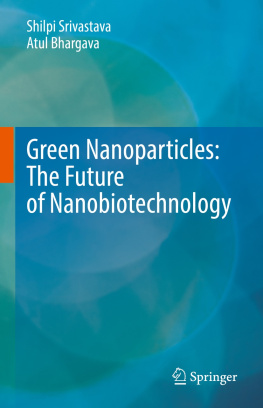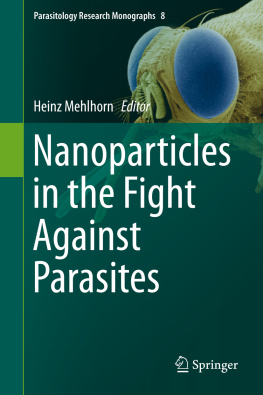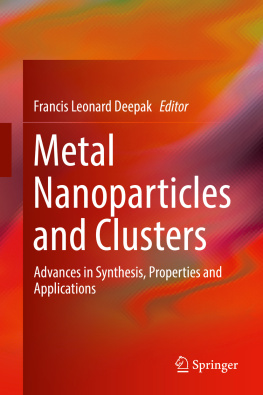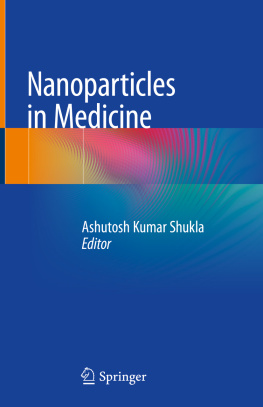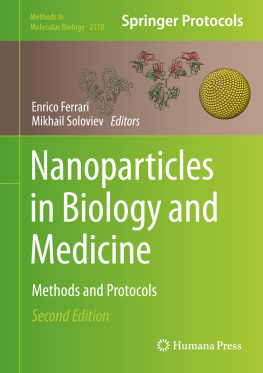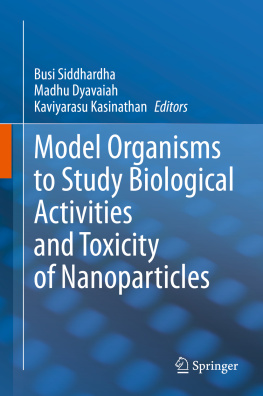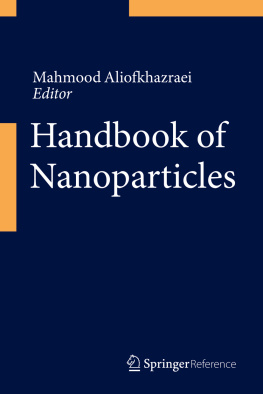Cao - Silver nanoparticles for antibacterial devices : biocomparibility and toxicity
Here you can read online Cao - Silver nanoparticles for antibacterial devices : biocomparibility and toxicity full text of the book (entire story) in english for free. Download pdf and epub, get meaning, cover and reviews about this ebook. City: Boca Raton, FL, year: 2017, publisher: CRC Press, genre: Romance novel. Description of the work, (preface) as well as reviews are available. Best literature library LitArk.com created for fans of good reading and offers a wide selection of genres:
Romance novel
Science fiction
Adventure
Detective
Science
History
Home and family
Prose
Art
Politics
Computer
Non-fiction
Religion
Business
Children
Humor
Choose a favorite category and find really read worthwhile books. Enjoy immersion in the world of imagination, feel the emotions of the characters or learn something new for yourself, make an fascinating discovery.
- Book:Silver nanoparticles for antibacterial devices : biocomparibility and toxicity
- Author:
- Publisher:CRC Press
- Genre:
- Year:2017
- City:Boca Raton, FL
- Rating:5 / 5
- Favourites:Add to favourites
- Your mark:
- 100
- 1
- 2
- 3
- 4
- 5
Silver nanoparticles for antibacterial devices : biocomparibility and toxicity: summary, description and annotation
We offer to read an annotation, description, summary or preface (depends on what the author of the book "Silver nanoparticles for antibacterial devices : biocomparibility and toxicity" wrote himself). If you haven't found the necessary information about the book — write in the comments, we will try to find it.
Cao: author's other books
Who wrote Silver nanoparticles for antibacterial devices : biocomparibility and toxicity? Find out the surname, the name of the author of the book and a list of all author's works by series.
Silver nanoparticles for antibacterial devices : biocomparibility and toxicity — read online for free the complete book (whole text) full work
Below is the text of the book, divided by pages. System saving the place of the last page read, allows you to conveniently read the book "Silver nanoparticles for antibacterial devices : biocomparibility and toxicity" online for free, without having to search again every time where you left off. Put a bookmark, and you can go to the page where you finished reading at any time.
Font size:
Interval:
Bookmark:

Huiliang Cao earned his PhD in materials science and engineering from South China University of Technology in 2008. After having worked for 2 years as a postdoctoral research scientist and another 2 years as an assistant professor at Shanghai Institute of Ceramics, Chinese Academy of Sciences (SICCAS), in 2012, he was promoted to associate professor. Dr Cao, as a member of the Chinese Society for Biomaterials and the Chinese Mechanical Engineering Society, centres on exploring the cellular responses to materials engineered with distinctive surface or interface properties, especially on developing antibacterial materials with selective toxicity.
Long Bai
Research Institute of Surface Engineering
Taiyuan University of Technology
Taiyuan, China
Uttam C. Banerjee
Department of Pharmaceutical Technology (Biotechnology)
National Institute of Pharmaceutical Education and Research
Punjab, India
Jayeeta Bhaumik
Department of Pharmaceutical Technology (Biotechnology)
National Institute of Pharmaceutical Education and Research
Punjab, India
Huiliang Cao
State Key Laboratory of High Performance Ceramics and Superfine Microstructure
Shanghai Institute of Ceramics
Chinese Academy of Sciences
Shanghai, China
Paul K. Chu
Department of Physics and Materials Science
City University of Hong Kong
Hong Kong, China
Bharat P. Dwivedee
Department of Pharmaceutical Technology (Biotechnology)
National Institute of Pharmaceutical Education and Research
Punjab, India
Ang Gao
Department of Physics and Materials Science
City University of Hong Kong
Hong Kong, China
Denis Girard
Laboratoire de recherche en inflammation et physiologie des granulocytes
Universit du Qubec, INRS-Institut Armand-Frappier
Laval, Quebec, Canada
Yingxin Gu
Department of Oral and Maxillo-facial Implantology
Shanghai Key Laboratory of Stomatology
Shanghai Ninth Peoples Hospital
Shanghai Jiao Tong University
Shanghai, China
Michael R. Hamblin
Wellman Center for Photomedicine
Massachusetts General Hospital
and
Department of Dermatology
Harvard Medical School
Boston, Massachusetts
and
Harvard-MIT Division of Health Sciences and Technology
Cambridge, Massachusetts
Ruiqiang Hang
Research Institute of Surface Engineering
Taiyuan University of Technology
Taiyuan, China
Steffen Foss Hansen
Department of Environmental Engineering
Technical University of Denmark
Lyngby, Denmark
Yan Huang
State Key Laboratory of Bioelectronics
School of Biological Science and Medical Engineering
Southeast University
Nanjing, China
Ying-Ying Huang
Wellman Center for Photomedicine
Massachusetts General Hospital
and
Department of Dermatology
Harvard Medical School
Boston, Massachusetts
Gitika Kharkwal
NAC-SCRT Secretariat
ICMR Headquarters
New Delhi, India
Feng Li
American Advanced Nanotechnology
Houston, Texas
Wirginia Likus
Department of Anatomy
School of Health Science in Katowice
Medical University of Silesia
Katowice, Poland
Xiaoying L
State Key Laboratory of Bioelectronics
School of Biological Science and Medical Engineering
Southeast University
Nanjing, China
Aiga Mackevica
Department of Environmental Engineering
Technical University of Denmark
Lyngby, Denmark
Lin Mei
Key Laboratory of Functional Polymer Materials of Ministry of Education
Institute of Polymer Chemistry
Nankai University
Tianjin, China
and
School of Materials and Chemical Engineering
Zhongyuan University of Technology
Zhengzhou, China
Erchao Meng
School of Material and Chemical Engineering
Zhengzhou University of Light Industry
Zhengzhou, China
Kristel Mijnendonckx
Unit of Microbiology
Expert Group Molecular and Cellular Biology
Belgian Nuclear Research Centre (SCKCEN)
Mol, Belgium
Magdalena Owieja
Jerzy Haber Institute of Catalysis and Surface Chemistry
Polish Academy of Sciences
Krakow, Poland
Tanya S. Peretyazhko
Jacobs, NASA Johnson Space Center
Houston, Texas
Pier Paolo Pompa
Istituto Italiano di Tecnologia
Genoa, Italy
Shichong Qiao
Department of Oral and Maxillo-facial Implantology
Shanghai Key Laboratory of Stomatology
Shanghai Ninth Peoples Hospital
Shanghai Jiao Tong University
Shanghai, China
Loris Rizzello
Department of Chemistry
University College London
London, U.K.
Sulbha K. Sharma
Laser Biomedical Section and Application Division
Raja Ramanna Centre for Advanced Technology
Indore, India
Krzysztof Siemianowicz
Department of Biochemistry
School of Medicine in Katowice
Medical University of Silesia
Katowice, Poland
Neeraj S. Thakur
Department of Pharmaceutical Technology (Biotechnology)
National Institute of Pharmaceutical Education and Research
Punjab, India
Rob Van Houdt
Unit of Microbiology
Expert Group Molecular and Cellular Biology
Belgian Nuclear Research Centre (SCKCEN)
Mol, Belgium
Qingbo Zhang
Department of Chemistry
Rice University
Houston, Texas
Xinge Zhang
Key Laboratory of Functional Polymer Materials of Ministry of Education
Institute of Polymer Chemistry
Nankai University
Tianjin, China
Werner Zimmerli
Basel University Medical Clinic
Liestal, Switzerland
Neeraj S. Thakur , Bharat P. Dwivedee , Uttam C. Banerjee and Jayeeta Bhaumik
Metal nanoparticles have been studied and applied in many areas including the biomedical, agricultural and electronic fields (Mittal et al. 2013). Several products of colloidal silver are already in the market. Research on new, eco-friendly and cheaper methods has been initiated. Biological production of metal nanoparticles has been studied by many researchers owing to the convenience of the method that produces small particles stabilised by protein. However, the mechanism involved in this production has not yet been elucidated, although hypothetical mechanisms have been proposed in the literature (Mittal et al. 2014). Thus, this chapter discusses the various mechanisms provided for the biological synthesis of silver nanoparticles (AgNPs) by plants, fungi and bacteria. One thing that is clear is that the mechanistic aspects in some of the biological systems need more detailed studies.
Research on nanoparticles is currently an area of intense scientific interest owing to a wide variety of potential applications in the biomedical, agricultural, optical and electronic fields (Ravindran et al. 2013; Tran et al. 2013). An important type of material that has been studied is metal nanoparticles because of their physicochemical and optoelectronic properties (Mittal et al. 2013). There are various physical and chemical methods employed for the synthesis of metal nanoparticles (Mittal et al. 2013). However, these methods have certain disadvantages as a result of the involvement of toxic chemicals and radiation. Therefore, research is shifting towards biological methods of synthesis of metal nanoparticles, as these are rapid, cost-effective and eco-friendly.
A constant demand exists for economic, commercially viable as well as environment-friendly synthetic routes to nanoparticles (Mittal et al. 2013). Bio-enthused synthesis of nanoparticles provides advantages over chemical and physical methods as it is environmentally-friendly, does not need high pressure and high temperature and no toxic chemicals are needed in biological methods (Mittal et al. 2014). Biomaterials such as bacteria, yeast, fungi and various parts of plants are used in nanoparticle synthesis (Mittal et al. 2013; Narayanan and Sakthivel 2010). Currently, most of the applications of AgNPs are in the biotechnology field as antibacterial and antifungal agents, in textile engineering, in wastewater treatment and as silver-based consumer products (Gade et al. 2010). Nanoparticles, which are mainly utilised in biomedical applications, fall within the size range of 1100 nm. The bioinspired method is considered to be ideal, amongst different synthetic routes to nanoparticle formation, since it avoids the use of toxic chemicals (Mittal et al. 2014).
Font size:
Interval:
Bookmark:
Similar books «Silver nanoparticles for antibacterial devices : biocomparibility and toxicity»
Look at similar books to Silver nanoparticles for antibacterial devices : biocomparibility and toxicity. We have selected literature similar in name and meaning in the hope of providing readers with more options to find new, interesting, not yet read works.
Discussion, reviews of the book Silver nanoparticles for antibacterial devices : biocomparibility and toxicity and just readers' own opinions. Leave your comments, write what you think about the work, its meaning or the main characters. Specify what exactly you liked and what you didn't like, and why you think so.

